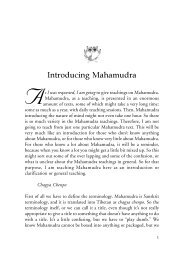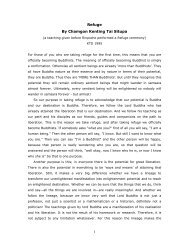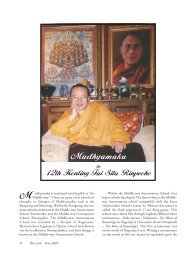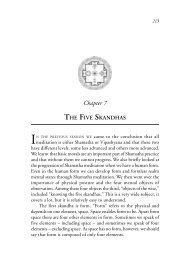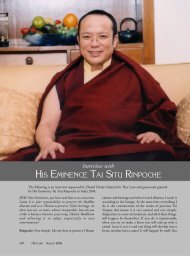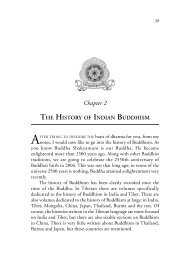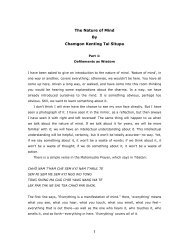Chenrezig Practice - December 2009.pdf
Chenrezig Practice - December 2009.pdf
Chenrezig Practice - December 2009.pdf
You also want an ePaper? Increase the reach of your titles
YUMPU automatically turns print PDFs into web optimized ePapers that Google loves.
the HRI. Then the HRI transforms into<br />
four-arm Avalokiteshvara sitting on<br />
the lotus.<br />
It is described here as, <strong>Chenrezig</strong><br />
radiating white clear light of five colours<br />
gazing with compassionate eyes and a<br />
loving smile, with four arms two folded<br />
in prayer. He has four arms: the upper two are joined<br />
together in the namaskar mudra and holding a wish<br />
fulfilling gem; a beautiful gem which can fulfil the wishes<br />
of all sentient beings. Whatever they wish, by the<br />
blessing and power of this gem their wishes are fulfilled.<br />
So a wish fulfilling gem is held in the namaskar mudra<br />
with the upper two hands. The lower two holding a crystal<br />
rosary and white lotus.<br />
Then, he is arrayed with jewels and silks, with a<br />
doeskin over his shoulder. This is an important symbol<br />
and many people in the West don’t understand this.<br />
They think that because you have to kill a deer to have<br />
a skin, how can a deerskin represent compassion? But<br />
in India we understand this, because many of our gods<br />
and goddesses have the deerskin representing<br />
compassion. A deer is a very peaceful animal and its<br />
skin represents the compassionate aspect of a<br />
bodhisattva, therefore a deerskin is here. It doesn’t mean<br />
we have to get a deerskin for ourselves to represent<br />
compassion, definitely not, but Avalokiteshvara has it<br />
here to represent peacefulness and compassion.<br />
Amitabha is his head ornament. Amitabha is the<br />
Buddha of the Western Paradise. Actually Buddha<br />
Amitabha represents the purified defilements of a human<br />
being. Out of the six realms the human defilement is<br />
attachment. Purification of attachment is contentment.<br />
When attachment is transformed then that is wisdom and<br />
that wisdom manifests as Buddha Amitabha. That Buddha<br />
is on the crown of Avalokiteshvara, above him in space.<br />
His two feet are in the vajra asana. Avalokiteshvara<br />
sits in the vajrasana, which is a cross-legged posture.<br />
Many translators translate it as ‘lotus-posture’, but I<br />
don’t understand where that comes from. Then it has<br />
to be ‘padmasana’. But it is not padmasana, it is<br />
vajrasana. A stainless moon supports his back. Again<br />
another crystal moon disc, identical to the one on which<br />
he is sitting, is also behind him. So he is sitting on a<br />
moon crystal disc which is white and shining and behind<br />
him is also a white and shining crystal<br />
moon disc, absolutely round.<br />
Avalokiteshvara has a five-dhyani-<br />
Buddha crown, all the jewellery of a<br />
sambhogakaya Buddha. He is a<br />
bodhisattva, but he has this jewellery,<br />
which represents the six paramitas. So<br />
there are six main items of jewellery: for the hands,<br />
legs, neck, crown, head, ears, and as a belt, and each<br />
one represents one of the paramitas. A female<br />
manifestation of a deity will have only five ornaments<br />
because she represents the wisdom paramita herself.<br />
But all the male deities have six ornaments because a<br />
male deity does not represent wisdom. So <strong>Chenrezig</strong><br />
has six ornaments. Vajravarahi will have only five out<br />
of the six ornaments, because she herself is a<br />
manifestation of wisdom.<br />
Then you say, he is the essence of all sources of refuge.<br />
That is your visualisation. When you have this<br />
visualisation very clearly, you yourself are here, and your<br />
father and mother, your friends and enemies, all your<br />
relatives and close friends and all other sentient beings<br />
are there, behind you. Also those who are strangers to<br />
us right now, but who actually have been our mother,<br />
father, brother, sister, friend, enemy and stranger<br />
countless times, and to be honest, who have also been<br />
our lunch and dinner countless times. We have a very<br />
close relationship with every sentient being, they have<br />
been everything to us.<br />
For example, even if you are not a meat eater, you<br />
are a vegetarian, in order for you to be able to eat rice<br />
many sentient beings died for you. Because if a farmer<br />
doesn’t use water to drown the ants in his field then you<br />
will not have rice to eat; the ants will eat it. Also if the<br />
farmers don’t spray—in the old days they sprayed lime,<br />
nowadays they spray poison, but nevertheless whatever<br />
they spray, they have to kill all the insects and bugs,<br />
and as the result of that we have nice juicy vegetables to<br />
eat. Otherwise they will be for the insects and bugs, we<br />
will not have them. So even if we are vegetarians we are<br />
not free from eating the product of death. Therefore, all<br />
of these sentient beings who are connected with us,<br />
positively, negatively, we have them all behind us like a<br />
sea of sentient beings, billions and billions of them<br />
stretching into limitless space. So we are chanting but<br />
DECEMBER 2009 I Thar Lam 5



